Duquesne Gardens
The Duquesne Gardens was the main sports arena located in Pittsburgh, Pennsylvania, during the first half of the 20th century. Built in 1890, the building originally served as a trolley barn, before becoming a multi-purpose arena. The Gardens opened three years after a fire destroyed the city's prior sports arena, the Schenley Park Casino, in 1896. Over the years, the Gardens was the home arena of several of Pittsburgh's historic sports teams, such as ice hockey's Pittsburgh Pirates and Pittsburgh Hornets. The Western Pennsylvania Hockey League, which was the first ice hockey league to openly hire and trade players, played all of its games at the Gardens. The arena was also the first hockey rink to ever use glass above the dasher boards. Developed locally by the Pittsburgh Plate Glass Company, Herculite glass was first tested in Pittsburgh. Most rinks were using wire mesh before the shatterproof glass was invented. Finally, the Pittsburgh Ironmen, a charter member of the Basketball Association of America (a forerunner of the National Basketball Association), played at the Gardens from 1946 to 1947.
"The Arena" "The Gardens" | |
 The Duquesne Gardens in the mid-1950s | |
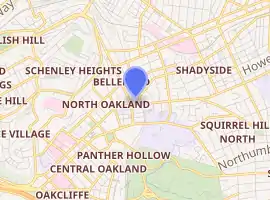
| |
| Former names | The Duquesne Traction Company |
|---|---|
| Address | 110 North Craig Street |
| Location | Pittsburgh, Pennsylvania |
| Capacity | 5,000 (hockey) 5,657 (standing room) 8,000 ("unofficial" capacity) |
| Surface | Ice, Wood |
| Construction | |
| Broke ground | 1886 |
| Built | 1890 Trolley Barn 1895 Ice Rink |
| Closed | 1956 |
| Demolished | August 13, 1956 |
| Construction cost | $500,000 (USD) ($15.4 million in 2021) |
| Tenants | |
| |
Outside team sports, the Duquesne Garden Ball Room, located on the arena's second floor, was also one of the largest dance halls in the country during the time.
History
Beginnings: 1890–1910
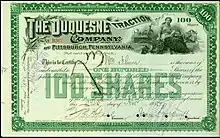
The Gardens was originally built in 1890 as the Duquesne Traction Company, which served Pittsburgh as a trolley barn, in the city's Oakland neighborhood. In 1895, Christopher Lyman Magee, a Pittsburgh politician, spent nearly $500,000 ($15.4 million in 2021) to purchase and renovate the building. He renamed the structure the Duquesne Gardens in 1896, although it was always called the "Arena" by the locals.[1] The Gardens, which had the world's largest indoor ice rink and a second-floor ballroom, became a premier indoor venue.[2]

Speed skating, roller skating, dance contests, musical performances, roller derby, bicycle racing, and college basketball were all hosted at the Gardens,[2] as were rodeos and the circus. The Gardens also featured Pittsburgh Golden Gloves boxing and housed a movie theater.[1] The Duquesne Garden Ball Room, located on the second floor, has been used by some of the leading clubs and societies in the city for their annual dances.[3] The building quickly became the site for all manner of gatherings: There were opera performances, boxing matches and political rallies.[4]
However, the facility's main attraction was its artificial ice surface, unrivaled in North America. Most other American cities lacked a facility that produced artificial ice at the time. And with 26,000 square feet of ice surface at the Gardens,[2] was nearly 50 feet longer than the modern-day rinks in the National Hockey League (NHL) and had state-of-the-art refrigeration and resurfacing technology.[1] On January 24, 1899, the Gardens hosted its first ice hockey game in a match between the Pittsburgh Athletic Club and Western University of Pennsylvania (University of Pittsburgh). According to Total Hockey, the official encyclopedia of the NHL, Pittsburgh was one of the first cities in North America to lure amateur Canadian players for what was a standard $30 a week stipend and a local job in the early 1900s. The manager of a Canadian team returned from a trip to the Gardens in 1902, according to an account in Total Hockey, and gave the following description to the Toronto Globe: "Pittsburgh is hockey crazy. Over 10,000 turned out for our three games there. The general admission being 35 cents and 75 cents for a box seat . . . the Pittsburgh rink is a dream . . . What a marvellous place it is."[5]
The teams of the Western Pennsylvania Hockey League, and the Pittsburgh Professionals of the International Professional Hockey League, played their games at the Gardens up until 1910. The Gardens' artificial ice surface helped make Pittsburgh a professional hockey pioneer, much the way the region had given birth to the first professional American football players in the 1890s. Players in the WPHL were paid to play hockey before 1904, but that is when the first professional league officially formed. The Pittsburgh Professionals joined Canadian Soo, Michigan Soo, Calumet Miners, and the Portage Lakes Hockey Club to form the IPHL in 1904. However, after the 1906–07 season, other professional leagues began popping up and the IPHL disbanded, while the WPHL was revived until 1910. During this era, Garnet Sixsmith, who played on several Pittsburgh teams, once scored 11 goals in a game at the Gardens. His 11 goals is considered to be a record for the arena.[6]
Olympics, Yellow Jackets and Pirates: 1910–1936
Between 1910 and 1915, hockey games were mostly played at the Winter Garden at Exposition Hall, located near the city's Point. Therefore, the Gardens was used mostly for recreational skating and amateur hockey matches for teams.[1] Crowds also attended skating sessions at Gardens and took part in public skating events. Public skating was held every evening, except on days for performances, with Saturday morning being set aside for school children who wanted to learn how to skate.[3]
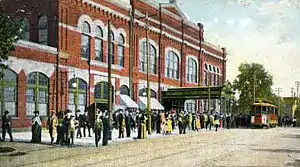
However in 1911, Lester Patrick started the Pacific Coast Hockey Association, and in order to learn how to generate artificial ice, he came to the Duquesne Gardens to study the procedure.[5] On March 16, 1920, the United States men's national ice hockey team was founded at the Gardens.[7] That same year at the Gardens, Roy Schooley, the arena's manager, put together an 11-player squad that won silver at the Antwerp Games, in the sport's Olympic debut.[7][8] The Gardens also hosted several contests, which were played on Mondays and Tuesdays, to help raise money in order to cover the expenses associated with sending the U.S. Olympic Hockey team to the games held in Antwerp, Belgium.[3]
In 1915, the Pittsburgh Yellow Jackets of the United States Amateur Hockey Association (USAHA) were founded. The team evolved from being an amateur to a semi-pro franchise. The Pittsburgh Athletic Associations's Seven, an amateur hockey club, as well as the Carnegie Tech hockey club and the University of Pittsburgh hockey team also played their home games at the Gardens in 1919. By 1924, the Yellow Jackets of the USAHA's Western Division were so dominant that they spun off another Pittsburgh team, the Hornets, who played in the Eastern Division. In 1925, both Pittsburgh club's won the respective divisions and played each other for the 1924-1925 USAHA championship at the Gardens. The Yellow Jackets won the title in a best of seven series, 4 games to none.[9]
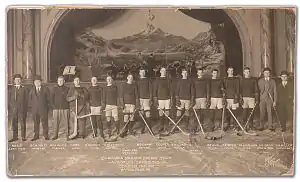
In 1925, the Yellow Jackets were sold to James Callhan and New York-based bootlegger William Dwyer and were renamed the Pittsburgh Pirates. The Pirates then joined the NHL on November 7, 1925. During this time, the Gardens' massive ice surface was reduced to conform to the NHL's standards. Pittsburgh's first ever NHL game was played on December 2, 1925, with the Pirates taking on the New York Americans in front of 8,200 fans. The Pirates lost the game in overtime, 2-1. By 1930, financial issues, associated with the Great Depression caused the Pirates to relocate to Philadelphia, before folding. What helped make the city such a hotbed for hockey in the early part of the century, the Duquesne Gardens, ultimately helped doom the Pirates. The Gardens held slightly more than 5,000 fans, which was fine at the turn of the century but small by comparison in the late 1920s to other arenas sprouting up, such as 18,000-seat Madison Square Garden. The Pirates did not make very much money playing in the 5,000 seat Gardens. The team was so strapped for money that they traded Conacher to the New York Americans during the 1926-27 season for a journeyman player and $2,000. Conacher had been the highest-paid NHL player at $7,500 a year. The Pirates later moved the team across the state to become the Philadelphia Quakers for the franchise's last season in 1930-31.[8]
However the Gardens still witnessed ice hockey even during these dark financial times. In 1930, Roy Schooley re-acquired the rights to the Yellow Jackets. The Jackets played for two years in the International Hockey League (IHL) before the team was purchased in 1932 by Pittsburgh theatre chain owner John H. Harris,[1] who purchased a new $5,000 sanitary soda fountain for the Gardens and renovated a portion of the building to become one of the largest dance halls in America, back in 1920.[3] By 1935, the Yellow Jackets returned to being an amateur club in the Eastern Amateur Hockey League. In 1936, Harris and the Yellow Jackets helped provide Pittsburgh with another professional hockey team, the Pittsburgh Shamrocks and established that the Gardens' ice time would be split by the new IHL team and the Yellow Jackets.[1]
Yellow Jackets' owner, John H. Harris, also leased Duquesne Gardens, and began scheduling events, including ice hockey, boxing, and rodeos.[10] One notable rodeo act to come to the Gardens was Roy Rogers and his horse Trigger, who performed there on April 30, 1945.[11]
Hornets, Ice Capades and Ironmen: 1936–1955
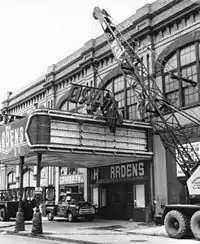
Several other historic events took place at the Gardens during Harris' tenure. First, on March 31, 1936 he hired Sonja Henie, a 24-year-old Norwegian figure skater, to perform before a Yellow Jackets' home game.[12] Harris found it difficult to draw a large crowd to hockey games during the Great Depression, so he hired Henie to entertain the audience between periods. The performances were a rousing success, and Harris soon set out to create an ice show to rival the song and dance spectaculars that were popular on Broadway.[10] He developed the Ice Capades, which premiered in September 1940. The skating corps of 150 young women clad in elaborate costumes captivated audiences. Harris's Ice Capades, founded in Pittsburgh with an $85,000 investment, was sold in 1963 for $5.5 million.[2] Harris also used the Gardens for Ice Capades auditions and as the show's training school, since many of the show's performers were from western Pennsylvania.[13]
Then on October 4, 1936, Harris purchased the Detroit Olympics and moved the team to Pittsburgh, where they were renamed the Pittsburgh Hornets, and became a member of the American Hockey League. Some players from the Yellow Jackets and Shamrocks players then joined the Hornets. The Yellow Jackets formally folded, while the Gardens would be home for the Hornets for the next 20 seasons. The Hornets played their first game at the Gardens on November 8, 1936, a 5-2 win over the Cleveland Barons. The franchise later won Calder Cups in 1951, versus the Providence Reds, and in 1955, versus the Buffalo Bisons. On January 10, 1956, the Gardens hosted the American Hockey League All Star Game for the city of Pittsburgh.[14]
However the Gardens was also the home for Duquesne University Basketball as well as the Pittsburgh Ironmen of the Basketball Association of America, a forerunner to the NBA. The team ended their only season in the BAA in 1946-47 with a record of 15-45. The Ironmen consisted of players like Press Maravich, a future college coach and father to Hall of Famer Pete Maravich, and Moe Becker.[15] The arena also hosted the first of 16 NBA neutral site regular season games played in Pittsburgh.
Another sport played at the Gardens was tennis. On January 15, 1937, the Gardens hosted a championship tennis match between world champions Ellsworth Vines and Fred Perry.[16]
Concerts
The Gardens also featured several notable concert acts throughout its history. On July 4, 1929, Jelly Roll Morton and his jazz band, the Red Hot Peppers, played the Gardens.[17] Then in August 1933, the arena hosted Cab Calloway and his orchestra. Segments of Calloway's show there was then broadcast over the radio.[18] The Gardens also hosted, opera singer, Enrico Caruso.[4]
Demolition and legacy
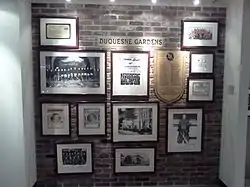
While the Gardens earned much praise in its early days, the place was outdated by the 1920s. About 15,000 fans could be comfortably seated in Madison Square Garden, Boston Garden, and Montreal Forum. Not even half that number could squeeze into the Gardens. Around this time, the ice-making operation at the Garden was antiquated. In November 1927, the Toronto Star reported that the Pirates had to train at a local gym instead of the Garden, since the Garden's ice machine had broken down.[19] However, while celebrating its 40th anniversary, the Garden still boasted as having one of the highest-regarded ice surfaces in North America, still drawing hockey players from Canada.[1]
The Gardens was demolished in 1956 to make way for an apartment building[8] and a local fixture, Stouffer's Restaurant.[1] Stouffer's, which became Duranti's Restaurant in 1979, featured the only remaining evidence of the Gardens, two 11-foot wide sections of exposed red brick wall, which would have been the back wall of the Gardens' visiting dressing room. Duranti's then closed in December 2008 and the apartment building that replaced the Gardens was to be torn down and renovated. Jim Kubus, the editor of pittsburghhockey.net, a local history site, and his brother removed the bricks before the wall could be destroyed and stored them for the next two years. Today, a Captain Morgan-sponsored lounge, which is located inside Pittsburgh's current multi-purpose arena, the PPG Paints Arena, contains a small section of that particular wall from the Duquesne Gardens.[8] Billy Conn, the famed Pittsburgh boxer who nearly won a match against Joe Louis, fought at the Gardens. On June 18, 1998, the intersection where the Gardens once stood was dedicated as "Billy Conn Blvd."[4]
Demolition of The Gardens brought a temporary end to professional ice hockey in Pittsburgh, as there was no other suitable arena to replace it. The Rochester Americans replaced the Hornets in the AHL. Construction of the Pittsburgh Civic Arena began in 1958, three miles to the west of the Gardens.
References
| Wikimedia Commons has media related to Duquesne Gardens. |
- "1896-1956 Duquesne Garden". Pittsburgh Hockey.net. Retrieved April 25, 2012.
- Madarasz, Anne (March 2008). "On Ice. Remembering Duquesne Gardens". Pittsburgh Sports Report.
- "Oakland: The World's Most Perfect Ice Palace". Pittsburgh Bulletin. October 9, 1920. Archived from the original on September 25, 2012.
- Potter, Chris (September 2, 2004). "What building did Pittsburgh's hockey team use before the Civic (Mellon) Arena was built?". Pittsburgh City Paper.
- Bouchette, Ed (May 2, 1999). "Ice Age". Pittsburgh Post-Gazette.
- "Garnet Sixsmith - He Played Hockey When A Rival Said "I'll Break Your Leg" And Did It". Pittsburgh Press. December 15, 1931. p. 29.
- Godin, Roger A. "1920 U.S. Olympic team born in Pittsburgh". Pittsburgh Hockey.net. Retrieved April 26, 2012.
- Klien, Jeff Z. (December 30, 2010). "Hockey Has Deep Roots in Pittsburgh". The New York Times.
- "St. Paul Athletic Club". Vintage Minnesota Hockey. 2010. Retrieved April 23, 2012.
- Macklin, Mike (December 31, 2009). "Let's Talk About: The Ice Capades". Pittsburgh Post-Gazette.
- "Rodeo Thrills Crowd". Pittsburgh Post-Gazette. May 1, 1945.
- Grove, Bob. "Pittsburgh hockey thriving for more than a century". Pittsburgh Hockey.net. Retrieved April 24, 2012.
- Hoover, Bob (March 6, 1990). "Ice Capades skates into 50th Anniversary". Pittsburgh Post-Gazette.
- "AHL All-Star Classic History". American Hockey League. Retrieved April 25, 2012.
- "Moe Becker". Jews in Sports. Archived from the original on March 8, 2012. Retrieved April 25, 2012.
- "Perry Will Make Pro Net Debut". Beaver County Times. January 5, 1937.
- "Red Hot Peppers "Red Hot" Dance". Pittsburgh Courier. July 6, 1929. p. 7.
- Morrow, Lynden (August 8, 1933). "Cab Calloway on Local Air". Pittsburgh Post-Gazette. p. 9.
- Christman, Paul. "Pittsburgh Pirates". Pittsburgh Hockey.net. Retrieved April 30, 2012.
| Preceded by Hershey Sports Arena |
AHL All-Star Classic 1956 |
Succeeded by Rhode Island Auditorium |
| Preceded by None |
Pittsburgh Pirates (NHL) Arenas 1925–1930 |
Succeeded by Philadelphia Arena |
| Preceded by Detroit Olympia |
Pittsburgh Hornets Arenas 1936–1956 |
Succeeded by Pittsburgh Civic Arena |
| Preceded by None |
Duquesne University Men's Basketball 1904-1956 |
Succeeded by Fitzgerald Field House |